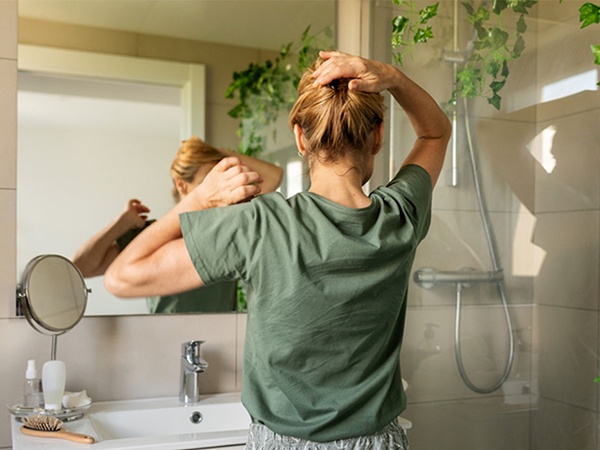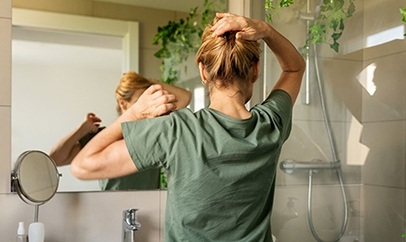
When you first notice your hair is falling out, there are likely a million different questions that spring to mind-the chief among them, ‘What the heck is going on?’ The first thing you should try to figure out is whether you’re dealing with hair shedding or hair thinning-because these are two very different things, and knowing which one you’re experiencing will help you determine the best form of treatment.
Both types of hair loss are alopecia, but “alopecia is a big generic term. Under that, there’s androgenetic alopecia, which is thinning hair, and there is telogen effluvium, which is shedding,” says Dr. Nader. When patients come in and say, “I’m losing hair,” he asks if they notice hair falling out or if they notice they see more scalp. “The treatment options for both are different. So it’s important to differentiate the two.”
These are two of the most common forms of hair loss. Here’s how to spot the difference between hair loss and hair shedding.
How can you tell if your hair is shedding?
“Everyone sheds 150 hairs a day,” says Dr. Nader, adding that if you don’t wash your hair frequently, you’ll notice what looks like a lot of hair coming out at once-but most derms consider that “normal.”
“It’s normal to have shed, but if you notice a significant increase in the shedding and the hair physically coming out, there are multiple things that may have caused it, whether it’s illness or work stress or home stress, which can trigger shedding,” says Dr. Nader.
Hair shedding is generally the type of hair loss most people experience as a result of stress, which triggers an influx of cortisol that shifts hair from its growth phase into its resting phase. When this happens, hair begins to fall out faster than it can grow in to replace itself.
The good news? “Generally, their hair comes back. You have to be patient and allow the hair to grow back,” says Dr. Nader. He notes that he’s seen an increase in this type of hair loss in his office due to the pandemic.
Know that this type of shedding can impact up to 50% of your strands, but it won’t cause your hair to come out in chunks-that type of hair loss is another beast entirely. If you notice a bald spot on the back of your head, for example, “that’s alopecia areata, which is an autoimmune type of process where your body’s own cells attack your hair follicles and cause your hair to fall out,” says Dr. Nader “That’s a whole different type of loss and the treatment for that is usually steroid injections to that area.” If you’re experiencing an uptick in shedding hairs all over, Dr. Nader says the best treatment is time.
“There’s not much to do from a treatment perspective,” he says. “Eat well, take care of yourself, reduce stressors, and keep your scalp clean and healthy. All those things are essential. It can take a year for the shedding to stop and then for the hair to grow again. So it could take a while. I try to reassure patients that this is not permanent hair loss.” If it has been a year and you do not see a change, it’s time to consult a doctor.
How can you tell if your hair is thinning?
When your hair is thinning, you likely won’t see any actual hairs coming out, but you will be able to see more of your scalp than usual.
“If you see more scalp, like the strands of hair getting thinner and thinner, that is a genetic or androgenetic alopecia,” says Dr. Nader. “You’re not technically losing hairs, they’re just thinning, but you see more of your scalp, so you look like you have more hair loss. In men, it thins, and eventually, it may fall out, and they go bald. In women, we see more thinning as a process that goes on.” If you haven’t cared for your scalp over time, thinning may become more evident as you age.
Dr. Nader notes that one of the best courses of treatment for thinning hair is minoxidil, the main ingredient in Rogaine.
“Minoxidil is beneficial for genetic pattern hair loss, which is thinning hair, because it can help to thicken the hair,” he says, “For people that come in with hair shedding, minoxidil really will not affect that.” He says the best option for men and women is Men’s Rogaine 5% Solution ($52).
Beyond Rogaine, other options require a doctor.
“There are medical and surgical options, like hair transplants,” says Dr. Nader. “Other than minoxidil, which has been around a long time, prescription options are available. There are also platelet-rich plasma injections, which can also be beneficial. So there is a spectrum of medical treatments that can be beneficial. Some are at home, and some have to come into the office, but options are available.


